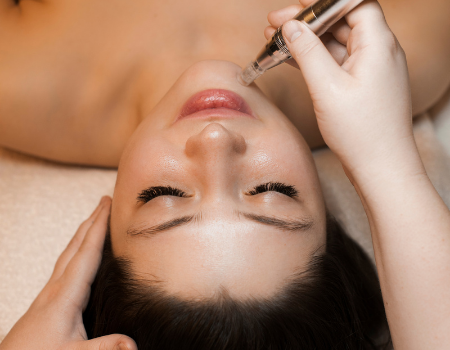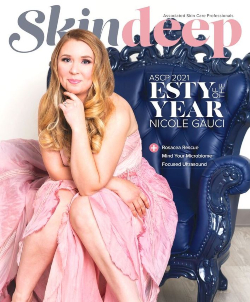Microneedling Plumps and Restores
Article by Maggie Staszcuk
This article appears in the July | August 2020 issue of ASCP Skin Deep magazine
 The practice of microneedling is nothing new; the modality has been around for more than 100 years. The use of microneedling was first recorded in 1905 by the German dermatologist Ernst Kromayer, who used dental burs mounted on a motordriven flexible cord to treat scars, birthmarks, and hyperpigmentation.1 Ninety years later, Dr. Desmond Fernandes developed a new technique to treat scars and wrinkles with the use of hypodermic needles. Around this time, Fernandes also developed a small needle stamp.2 Today, the seemingly barbaric methods of microneedling have changed thanks to new technology and US Food and Drug Administration (FDA) regulations.
The practice of microneedling is nothing new; the modality has been around for more than 100 years. The use of microneedling was first recorded in 1905 by the German dermatologist Ernst Kromayer, who used dental burs mounted on a motordriven flexible cord to treat scars, birthmarks, and hyperpigmentation.1 Ninety years later, Dr. Desmond Fernandes developed a new technique to treat scars and wrinkles with the use of hypodermic needles. Around this time, Fernandes also developed a small needle stamp.2 Today, the seemingly barbaric methods of microneedling have changed thanks to new technology and US Food and Drug Administration (FDA) regulations.
WHAT IS MICRONEEDLING?
Stated simply, microneedling inserts tiny needles into the skin, causing tiny wounds to stimulate the body’s natural healing response. These microchannels then fill with new collagen, elastin, and hyaluronic acid, leaving the skin looking plump, pink, and glowing for weeks. The depth of needle penetration is dependent on several factors, including skin condition and each state’s scope-of-practice rules. Also known as collagen induction therapy, microneedling is used to improve conditions including rough or uneven skin texture, crepe-like appearance, scarring, fine lines, and wrinkles. This technique can also be used to diminish pigmentation. According to a 2008 study, skin treated with four microneedling sessions one month apart showed an increase in the production of collagen and elastin of up to 400 percent, six months post treatment.3
INDICATIONS AND CONTRAINDICATIONS
Microneedling is a minimally invasive procedure with no downtime; however, performing a proper consultation and prepping the skin are key to a positive outcome. The healing ability of skin slows down as we age, so it is important to prep the skin with high-quality skin care leading up to the treatment, and then to ensure your client is following post-care instructions, including using a daily sunscreen. Although microneedling is indicated for all skin types, higher Fitzpatrick skin types should proceed with caution and be prepped with a skin lightener to reduce melanocyte activity for several weeks leading up to the treatment. Clients with active acne should also avoid receiving any microneedling treatments until their condition is under control, as it could result in the spread of bacteria and lead to infection. Clients suffering from severe rosacea may also experience flare-ups or infection as well. Additional contraindications include bleeding disorders, active herpes simplex, skin infections in the area to be treated, eczema, and psoriasis. When in doubt, don’t treat, and always refer your clients with suspicious lesions and disorders to their dermatologist.
FAQs
Does microneedling hurt?
Microneedling may cause slight pain and discomfort, especially near the "bonier" areas of the face like your forehead or jawline.
How much does microneedling cost?
The average cost for a session of microneedling may cost anywhere from $200 to $700.
How often should you microneedle?
Microneedling can be performed every four to six weeks.
What should you put on your skin after microneedling?
After your microneedling procedure, make sure you are gently cleansing and moisturizing your skin. Avoid using exfoliants and invest in a good hyaluronic acid to stimulate the healing process. Be sure to protect your skin by applying sunscreen daily.
The award-winning ASCP Skin Deep magazine is the premier estheticians' source for the latest trends, techniques, products, and news from the biggest names in the industry. In this issue:
• The Other Side of Fear: Meet ASCP's Esty of the Year and hear her inspiring story
• Rescue and Rebuild: Get advice on how to identify the signs of rosacea
• Mind Your Microbiome: Learn about the connection between our microbiome and our gut
 Liability Insurance
Liability Insurance
Professional liability insurance for microneedling protects you in case a client sues. ASCP members have access to optional microneedling insurance and other advanced modalities like permanent makeup, microblading, and radio frequency services. More information about microneedling insurance and advanced esthetic coverage that protects you and your esthetics practice, including the steps for applying, visit www.ascpskincare.com/ami. Pricing for microneedling insurance ranges from $592 - $692 for the year, and you can bundle that coverage with other advanced modalities to save more.
EXPLORE ADVANCED COVERAGE OPTIONS
- Log in to post comments
